From Mount Sinai to Revelation, explore how lightning in the Bible signifies divine power and judgment, revealing layers of meaning.
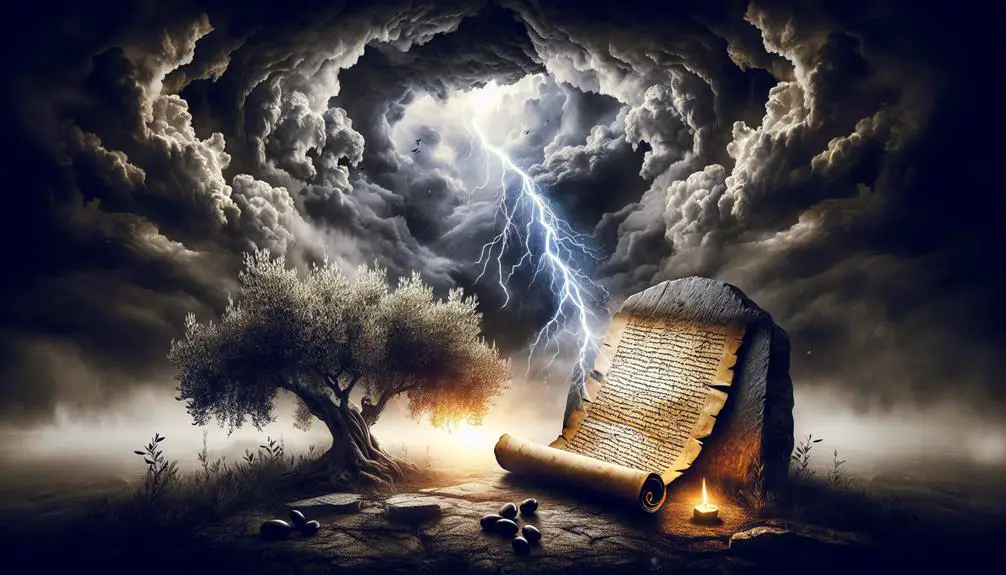
Lightening in the Bible
In the vast expanse of biblical narrative, lightning crackles with more energy than a thousand suns, illuminating not only the sky but also the profound messages woven throughout the scriptures. You'll find its presence awe-inspiring, from the awe-striking display at Mount Sinai to the prophetic visions in Revelation, where it signifies divine power and judgment.
Yet, there's more to lightning than just a spectacle; it's a multifaceted symbol that guides, warns, and teaches. As we explore its role, you'll discover layers of meaning that may just change the way you view the ancient texts and their relevance today.
Key Takeaways
- Lightning in the Bible symbolizes God's power, presence, and divine judgment.
- It often accompanies significant events, highlighting God's communication with humanity.
- Lightning serves as a metaphor for divine wrath, purification, and renewal.
- Contemporary interpretations view lightning as a call for environmental stewardship and spiritual awakening.
The Symbolism of Lightning
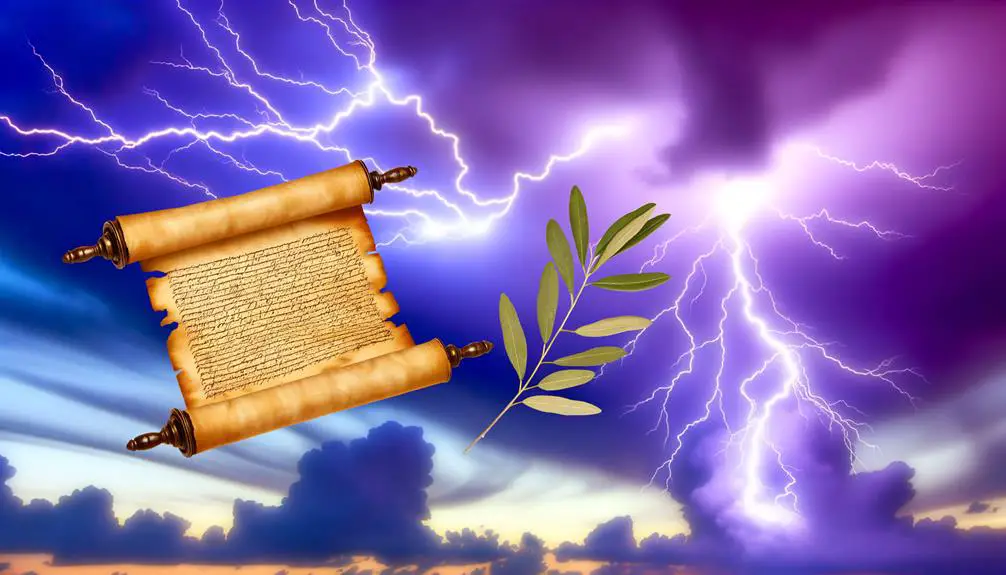
Throughout biblical scriptures, lightning serves as a potent symbol of divine power and judgment, reflecting God's omnipotence and intervention in human affairs. This imagery, infused with electric metaphors, underscores the immediacy and unchallengeable force of divine will. Lightning, as a celestial phenomenon, embodies celestial communication, a direct line from the divine to humanity, signaling both presence and power.
In analyzing these electric metaphors, you find that they're not mere embellishments but serve a deeper, theological purpose. The suddenness and irrefutable nature of lightning parallel the unexpected and incontrovertible nature of God's messages and judgments. As seen in scriptures, lightning often precedes significant events or revelations, acting as a harbinger of divine intervention. This celestial communication underscores a key aspect of the divine-human relationship; it's direct, powerful, and leaves little room for doubt.
Furthermore, the visual and auditory impact of lightning mirrors the awe-inspiring and sometimes fearful respect that God's presence demands. It's a reminder of the vast gap between human and divine power, urging humility and reverence. In a scholarly context, this analysis of lightning as a symbol in biblical texts reveals not just a literary device but a deeply embedded cultural and religious understanding of the divine. This understanding is shaped by natural phenomena, which are seen as manifestations of divine will and communication.
Lightning at Mount Sinai
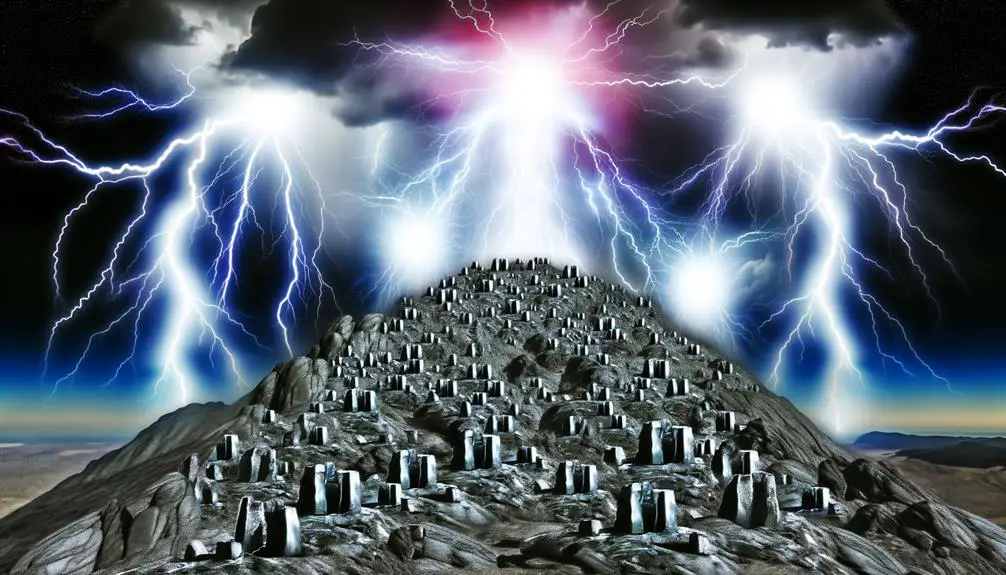
You must consider the vivid depiction of Sinai's fiery display as a crucial element in understanding the divine presence manifestation, as recounted in Exodus 19:16-20.
This event, marked by thunder, lightning, and a thick cloud, signifies a pivotal moment where divine power and authority are communicated to the Israelites.
Scholars like Durham (1987) argue that this demonstration serves not only as a physical manifestation but also as a symbolic act of covenant establishment between God and His people.
Sinai's Fiery Display
At Mount Sinai, the appearance of lightning served as a profound manifestation of divine presence, marking a pivotal moment in biblical history. When you delve deeper into this event, you'll find that:
- Geological Explanations: Scholars like Friedman (1987) suggest that the region's unique geological features could naturally produce frequent lightning, offering a real-world basis for the biblical descriptions.
- Historical Accounts: Ancient texts beyond the Bible, such as Josephus's writings, corroborate the occurrence of lightning during significant events, providing a broader context.
- Symbolic Interpretation: Theologians interpret this lightning as a symbol of God's power and a sign of the covenant with the Israelites, as detailed in Exodus 19:16-20.
In analyzing Sinai's fiery display, you're witnessing the intersection of divine narrative and natural phenomena, offering a rich tapestry for theological and historical exploration.
Divine Presence Manifestation
In the midst of Mount Sinai's rugged terrain, lightning's role as a divine indicator not only encapsulates God's omnipotence but also marks a covenantal milestone in biblical narrative, as outlined in Exodus 19:16-20. This episode underscores how celestial events and atmospheric phenomena can serve as mediums for divine revelation.
Here, lightning isn't just an environmental occurrence; it's a theophany, a visible manifestation of God to humans. This event signifies God's immanence and transcendence, demonstrating His power to communicate directly with His chosen people through nature. The integration of lightning as a sign of God's presence elevates the narrative, merging the physical with the spiritual, and highlights the multifaceted ways in which the divine interacts with the world.
Visions in Revelation
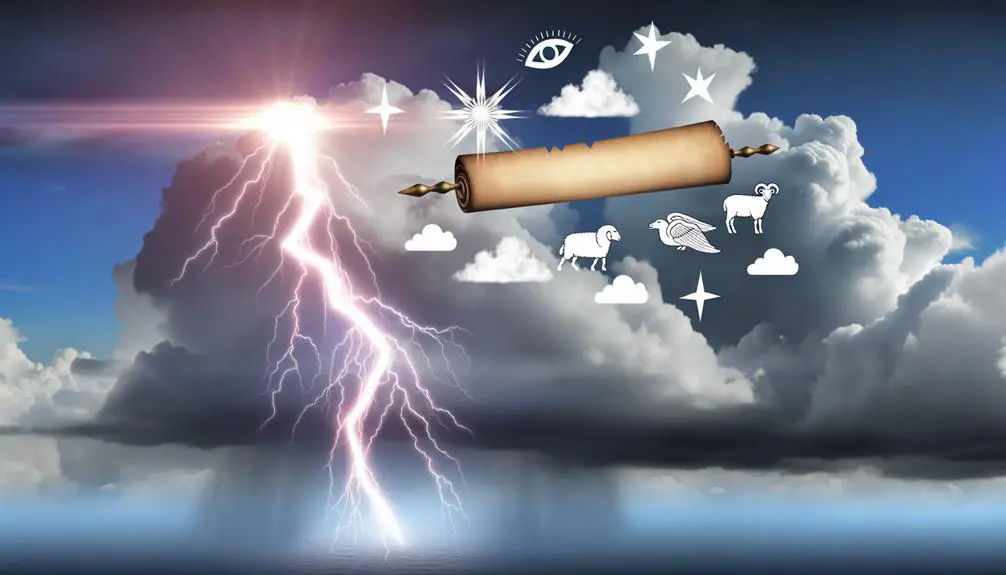
Revelation's visions, rich in symbolism and prophetic imagery, offer a complex tableau of divine judgment and salvation, demanding rigorous examination and interpretation. You're invited to delve into a world where heavenly messages and apocalyptic horsemen signal the unfolding of the end times, as portrayed in the Book of Revelation. This analysis will guide you through key aspects that underscore the multifaceted nature of these visions.
Here are three pivotal elements to consider:
- Heavenly Messages: The narrative commences with messages to the seven churches, which serve as a microcosm of divine communication to humanity. Each message, while specific to its recipient, collectively portrays a universal call to faithfulness and repentance in anticipation of the end (Rev. 2-3).
- Apocalyptic Horsemen: The opening of the seven seals introduces the famed Four Horsemen of the Apocalypse, symbolizing conquest, war, famine, and death (Rev. 6:1-8). These figures metaphorically illustrate the trials and tribulations that precede the final judgment, challenging readers to interpret their significance in light of contemporary and future events.
- Prophetic Imagery: Revelation's use of vivid, sometimes bewildering, imagery—ranging from beasts to battles—encourages a deeper exploration of its prophetic messages. The text employs symbols that resonate with its original audience while also inviting modern readers to seek out its relevance today (Rev. 13).
In engaging with Revelation's visions, you're embarking on a scholarly journey that bridges ancient prophecy with contemporary understanding, urging a reflective examination of its enduring significance.
Divine Wrath and Lightning
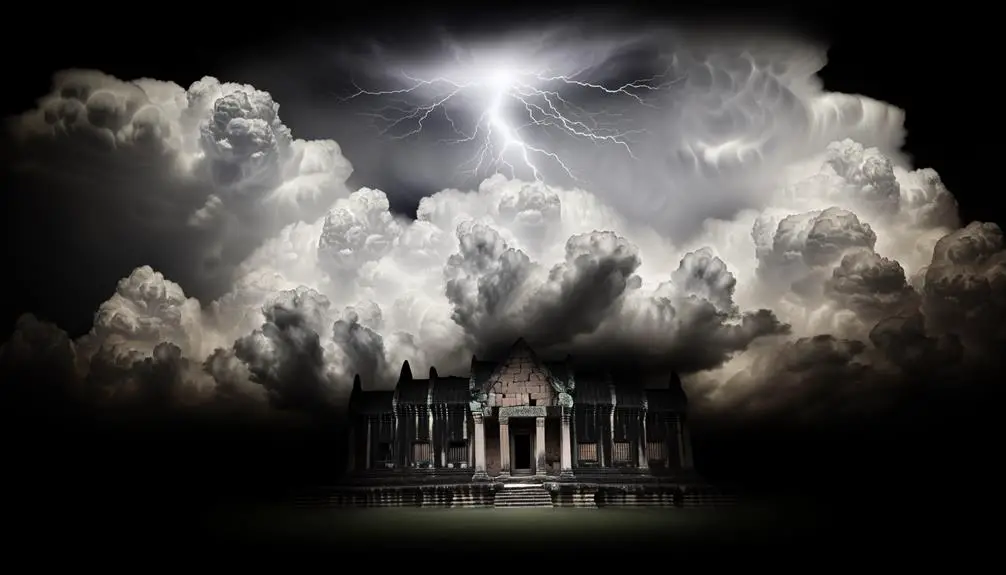
You'll find that Scripture frequently employs lightning as a symbol of divine wrath and a demonstration of God's omnipotent power.
For instance, the Book of Exodus (19:16) vividly portrays lightning accompanying God's descent onto Mount Sinai, emphasizing His majesty and the severity of His judgments.
This motif reoccurs in the New Testament, where lightning accompanies significant divine actions, underscoring the dual nature of God's communication through both punishment and revelation (Luke 10:18).
Lightning as Punishment
Throughout biblical narratives, lightning often serves as a manifestation of divine wrath, symbolizing God's punishment for human transgressions. This electrifying phenomenon isn't just a natural occurrence; it's imbued with spiritual significance, underlining the gravity of defying divine mandates. Lightning, amidst storm warnings, acts as a stark reminder of Nature's sovereignty, a force that transcends human control and understanding.
To grasp this concept, consider:
- Lightning as a harbinger of punishment – It's not merely a meteorological event but a divine signal of displeasure.
- The symbolic role of storms – They often precede or accompany lightning, serving as a prelude to divine retribution.
- Nature's sovereignty – Lightning underscores the power of the divine over nature and, by extension, humanity.
This perspective enriches our understanding of divine wrath and its manifestations.
Signs of God's Power
In biblical narratives, lightning serves not only as a meteorological phenomenon but also as a profound manifestation of God's omnipotence, signaling divine displeasure and judgment. This emblematic use of lightning underscores God's authority, emphasizing the supernatural aspect of these occurrences.
Throughout Scripture, lightning symbolizes God's power to intervene in human affairs, often accompanying miraculous events. For instance, the story of Mount Sinai, where lightning heralds God's presence and the delivery of the Ten Commandments, showcases this dynamic interaction (Exodus 19:16-19).
In these contexts, lightning transcends its natural origins, becoming a divine tool of communication. It's a visual and auditory demonstration of God's might, serving both as a warning and a reminder of His supreme authority over creation.
Guidance Through Lightning

Lightning, as depicted in the Bible, often serves as a divine signal, guiding individuals and nations through pivotal moments in their spiritual journeys. This celestial phenomenon isn't just a display of awe-inspiring power; it's a complex symbol interwoven with messages of guidance and direction. Within the tapestry of biblical narratives, lightning emerges as a tool of divine navigation, offering both literal and metaphorical storm guidance.
To understand how lightning functions as a guide, consider the following:
- Storm Guidance: Ancient people looked to the heavens for signs and wonders, interpreting natural phenomena as divine messages. In the Bible, lightning could signify God's presence and direction during tumultuous times. This celestial navigation, so to speak, offered reassurance and a path forward through the metaphorical and sometimes literal storms of life.
- Celestial Navigation: Beyond its immediate visual and auditory impact, lightning served as a means of celestial navigation, guiding the faithful towards their spiritual destinations. This wasn't just about finding one's way in the physical world but also navigating the moral and spiritual challenges of life.
- Symbolic Interpretation: The Bible often uses natural phenomena symbolically to represent God's guidance. Lightning, with its sudden illumination, can symbolize sudden insight or revelation, guiding individuals towards understanding and decision-making.
In analyzing the biblical text, it's clear that lightning was much more than a weather phenomenon; it was a multifaceted symbol of guidance, serving both as a navigational aid and a metaphor for divine illumination and revelation.
Lightning in Prophecy
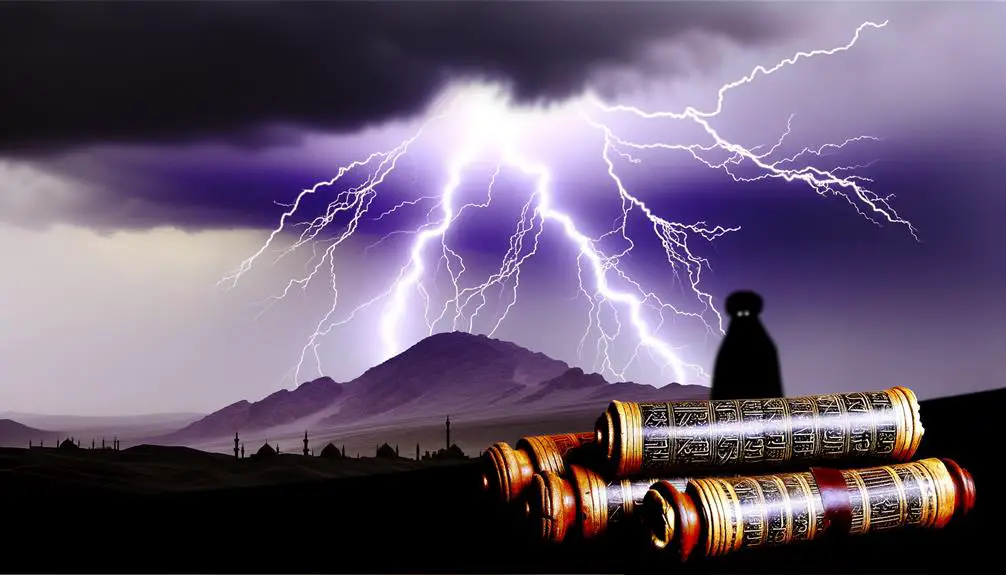
Beyond serving as a guide through storms, lightning also plays a pivotal role in biblical prophecy, where it symbolizes divine intervention and the unfolding of end-times narratives. As you delve into the scriptures, you'll find that lightning isn't just a meteorological phenomenon but a powerful element of apocalyptic imagery. It's used to convey the majesty, power, and judgment of God, particularly in prophetic books like Revelation and Daniel.
Prophetic interpretations often highlight lightning as a harbinger of divine retribution or a prelude to significant cosmic events. For instance, in Revelation 4:5, lightning emanates from the throne of God, accompanied by thunder and voices, setting the stage for the heavenly visions that follow. This imagery isn't merely for dramatic effect; it signals the commencement of God's judgment and the fulfillment of his promises.
Similarly, in the Old Testament, the Prophet Daniel describes visions where lightning symbolizes the swift and irresistible power of the Almighty. These instances underscore the belief that lightning, in its suddenness and intensity, mirrors the unexpected and all-encompassing nature of divine intervention.
The inclusion of lightning in these prophetic narratives isn't arbitrary. It's a carefully chosen symbol that enhances the apocalyptic imagery and emphasizes the omnipotence of God. As you study these texts, it becomes evident that lightning serves as a visual and metaphorical cue, guiding the faithful through the complexities of prophecy and reminding them of the power and presence of the divine in the world's ultimate destiny.
Lessons From Biblical Lightning
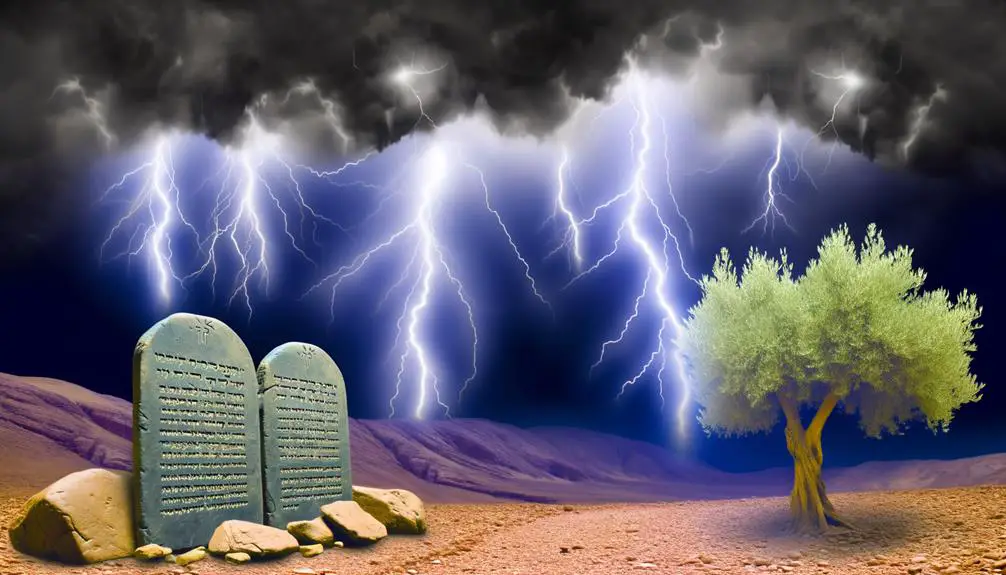
Drawing from biblical narratives, one can glean profound lessons about divine communication and human response through the symbolism of lightning. The Bible often uses electrical metaphors and storm narratives to convey messages of power, judgment, and revelation. These instances aren't merely for dramatic effect but carry deeper theological significance that resonates with the human experience of awe and humility before the divine.
Here are three key lessons to consider:
- Lightning as Divine Communication: In several passages, lightning accompanies the voice of God, serving as a powerful visual and auditory signal of divine presence (Exodus 19:16-19). This teaches us that God's methods of communication are multifaceted and transcend human understanding, urging us to pay attention to the various ways in which the divine seeks to connect with us.
- The Purifying Aspect of Lightning: Lightning often precedes rain in storm narratives, symbolizing purification and renewal (Leviticus 9:24). This metaphor encourages self-reflection and the cleansing of one's heart and mind to foster a closer relationship with the divine.
- Human Response to Divine Power: The awe-inspiring nature of lightning reflects the overwhelming power of God, eliciting responses of fear, reverence, and worship (2 Samuel 22:14-15). It reminds us of the importance of humility and the recognition of our place within the grander scheme of creation.
In analyzing these biblical lightning narratives, one discovers that they're more than mere stories. They're intricate electrical metaphors that convey profound truths about our relationship with the divine, encouraging a thoughtful and reverent approach to life's storms.
Contemporary Interpretations
In modern theological discourse, scholars have expanded upon ancient texts to offer fresh perspectives on the symbolism of lightning, examining its implications for contemporary faith and spirituality. This reevaluation isn't merely academic; it reaches into the very core of how modern believers interpret the divine within the natural world. The juxtaposition of lightning's destructive power and its illuminative beauty presents a paradox that modern interpretations seek to unravel.
You'll find that contemporary scholars like Thompson (2018) argue that lightning, as depicted in the Bible, serves as a metaphor for God's unbridled power and the suddenness of divine revelation. This interpretation isn't stagnant; it evolves as our world changes, reflecting current understandings of nature, science, and divinity. For instance, in the context of environmental crises, lightning's symbolism extends to represent divine warning against humanity's exploitation of the earth.
The cultural impact of these modern interpretations can't be understated. In today's society, where spirituality often intersects with environmentalism, lightning becomes a potent symbol for both the awe of creation and the urgency of environmental stewardship. Jacobs (2020) highlights how contemporary faith communities have incorporated this duality into their teachings, using the biblical imagery of lightning to foster a deeper connection between spirituality and ecological consciousness.
In essence, the ongoing exploration of lightning in biblical texts exemplifies how ancient symbols can acquire new life in modern contexts, enriching our spiritual landscape. These interpretations serve not only as reflections on divinity but also as a mirror to society's evolving values and concerns.
Frequently Asked Questions
How Have Different Translations of the Bible Affected the Interpretation of Passages Involving Lightning?
Different translations of the Bible have led to various interpretive challenges, particularly in passages involving lightning. These translation variations can significantly alter your understanding of the text, affecting both the literal and metaphorical meanings.
Scholars often debate the impact of these differences on theological interpretations. It's crucial for you to consider the version you're reading, as each may offer a distinct perspective on the biblical narrative and its symbolism.
What Are the Historical Contexts Behind the Biblical Events Associated With Lightning?
You're diving into how events with lightning are framed historically, focusing on divine symbolism and meteorological understanding.
Lightning wasn't just a weather phenomenon; it symbolized divine intervention or anger in many cultures. With advancements in meteorology, interpretations shifted, blending scientific explanations with symbolic meanings.
Analyzing these events, you see a transition from seeing lightning as purely divine retribution to a natural occurrence with spiritual significance, reflecting the evolving human understanding of nature and the divine.
Are There Any Archaeological Findings or Artifacts That Support Biblical Narratives Involving Lightning?
In your quest to connect dots between myths and reality, you're diving into whether archaeological discoveries back up tales involving lightning.
While lightning myths abound across cultures, finding direct geophysical evidence linking them to specific biblical narratives proves challenging. Scholars analyze artifacts and natural sites for clues, yet concrete connections remain elusive.
This scholarly pursuit requires piecing together historical, geological, and textual analyses to understand the ancient world's interpretation of lightning's power.
How Do Non-Christian Religions and Cultures Interpret the Phenomenon of Lightning in Their Spiritual or Mythical Texts Compared to the Bible?
In exploring how non-Christian religions view lightning, you'll find fascinating parallels and contrasts.
For instance, Zeus mythology portrays him wielding lightning as a divine weapon, symbolizing supreme power. Similarly, Thor's hammer in Norse myth isn't just a weapon but a tool that controls lightning, emphasizing strength and protection.
These stories, while differing in narrative and symbolism, share the idea of lightning as a potent, divine force, akin yet distinct to biblical interpretations.
In What Ways Have Artists and Musicians Been Inspired by Biblical Depictions of Lightning Throughout History?
Artists and musicians have long been captivated by the potent imagery of lightning, drawing inspiration for their works. This fascination isn't just about the physical phenomenon, but its rich symbolism too.
In modern adaptations, you'll find lightning representing divine intervention or sudden enlightenment. From Renaissance paintings to contemporary pop songs, the influence is evident, showcasing how this natural spectacle continues to spark creativity across different mediums and eras.
Conclusion
In your journey through the biblical tempest, you've witnessed lightning not just as meteorological phenomena, but as a divine Morse code, echoing from Mount Sinai to the apocalyptic visions of Revelation. This celestial fire, symbolizing wrath, guidance, and prophecy, illuminates the scriptures, inviting a reflection on its multifaceted roles.
As contemporary seekers, interpreting these ancient flashes requires a discerning eye, akin to interpreting Shakespeare's storms—not just as plot devices, but as windows into the soul of the narrative. In this light, biblical lightning transcends its physical form, becoming a beacon for spiritual and moral guidance across ages.



Sign up